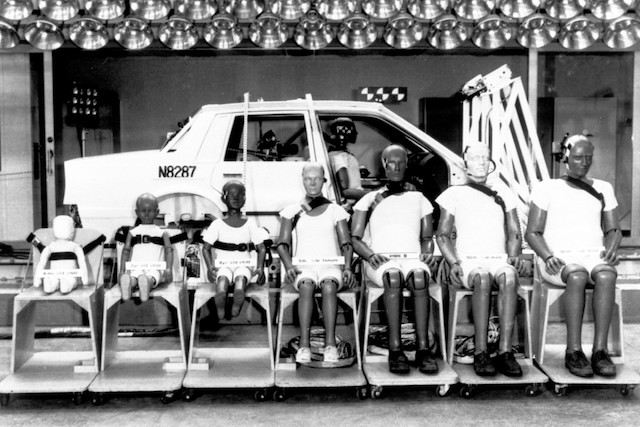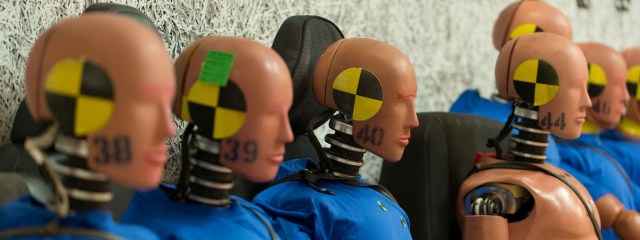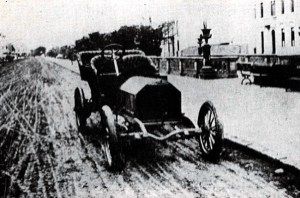Imagine being strapped into a car as it accelerates to 35 mph and collides head-on into a concrete barrier. Then you get into a second car, which is immediately T-boned by a 3,000-pound moving object. As a finale, you’re in a third car as it drives along at 55 mph before hitting a ramp and rolling over.
Welcome to the life of a crash test dummy.
By any measure, cars today are safer than they’ve ever been. That’s in no small part due to the development of crash test dummies. Anthropomorphic test devices, as they’re known in the scientific world, have evolved into highly sophisticated tools capable of closely mimicking a human’s response during a car crash. That information, in turn, is used by researchers, car designers and engineers to make automobiles as safe as possible.
It’s not an overstatement to say these dummies are life savers.
The History of Crash Testing
Before there were crash test dummies, there needed to be crash tests.
When it came to improving vehicle design during the early 20th century, however, safety was a distant-second consideration. Automobile manufacturers instead focused on making cars more aesthetically pleasing, with streamlined bodies, oval windows and wide roof pillars.
Unfortunately, these design features typically made cars less safe. It wasn’t until auto-related fatalities continued to soar in the 1930s and ’40s that car makers began to incorporate safety improvements into their designs.
https://www.youtube.com/watch?v=BPQdlJZvZhE
In 1934, General Motors became the first car maker to crash test its vehicles when it collided an unoccupied car into a concrete barrier. By the 1950s, universities including Cornell, UCLA and Wayne State began conducting their own crash tests, which proved the effectiveness of vehicle safety features, most notably the seat belt.
Increased safety studies, coupled with Ralph Nader’s seminal book, “Unsafe at Any Speed: The Designed-in Dangers of the American Automobile,” forced the government into action. In 1968, the National Traffic and Motor Vehicle Safety Act went into effect, mandating seat belts in all new cars.
The National Highway Transportation Safety Administration was established just two years later. In 1978, the government agency conducted its first crash test, a 35-mph frontal collision. The NHTSA began side impact testing nearly two decades later, and eventually added rollover resistance tests in 2000.
NHTSA is one of the two primary organizations conducting crash tests today, along with the Insurance Institute for Highway Safety. The independent agency funded by America’s insurance companies began its own crash test studies in the mid-1990s. Today’s IIHS tests are more extensive than its government counterpart’s. Not only does IIHS conduct six crash tests to NHTSA’s four, it also studies a vehicle’s crash avoidance and mitigation ability.
The History of Crash Test Dummies
The first crash tests were done on unoccupied vehicles. This usually involved the driver jumping out of the moving car before the collision.
Eventually, cadavers were used to allow researchers to see how crashes affected a human body. But dead bodies, of course, do not react the way living, breathing, moving bodies do. Matters were further complicated when testing progressed to include survivability, something that clearly could not be measured on a cadaver.
Researchers eventually moved on to using animal subjects, including primates and even bears. The most commonly used animal, however, was a pig due to the fact that it has the same thoracic and abdominal organs as humans. While testing on living creatures provided new insight, the significant differences between man and animal prevented researchers from gaining practical crash test data. A better solution was needed.
The history of crash test dummies began in the 1940s, when they were developed for the U.S. Air Force to use in the testing of aircraft ejection seats. The first dummy was created by Sierra Engineering Company and Alderson Research Laboratories, named after founder Sam Alderson. Their humanoid invention was aptly dubbed “Sierra Sam.”
In 1968, Alderson debuted the first crash test dummy designed specifically for automotive testing. It was known as the VIP, short for “vehicular impact personnel.” Consisting of a steel rib cage, articulated joints, flexible neck and cavities to hold instrumentation, it was designed to mimic the acceleration and weight distribution properties of an average male, according to the American Physical Society. The VIP series expanded to include crash test dummies that represented large males and averages females.

The Hybrid Dummies
Up until the early 1970s, crash test dummies were supplied by independent companies. That all changed when General Motors became dissatisfied with the options on the market and developed its own, instead.
In 1971, the auto maker created the Hybrid I dummy, which incorporated features from the VIP series, along with those from Sierra Engineering and some of GM’s own designs. It was followed the next year by Hybrid II, which more closely mimicked human anatomy and provided consistent results.
These early Hybrid were primarily designed to test the effectiveness of seat belts, according to Humanetics, one of today’s premier crash test dummy manufacturers. A more sophisticated dummy would be needed to determine the effect a crash would have on the head, neck and limbs of car occupants, including those of different genders, ages and sizes.
GM solved this before the close of the decade with the introduction of the Hybrid III. Not only was it the most humanlike crash test dummy ever made, it contained 41 channels of information. (The Hybrid II had just eight.) This allowed researchers to precisely measure injuries to susceptible parts of the body, including the head, torso and legs.
Originally developed to replicate an average male, the Hybrid III line was expanded in the 1980s to include large male and small female dummies. Child models were introduced in the 1994.
Vince and Larry
Fewer than 20% of Americans reported wearing seat belts in the early 1980s, more than a decade after the safety feature became mandated in all new cars. To spur a change in public behavior, NHTSA unveiled a new advertising campaign in 1985 aimed at getting drivers and passengers to buckle up.
And who did the agency call upon to direct the public’s attention to this life-saving issue? Crash test dummies, of course.
With the tagline, “You could learn a lot from a dummy,” the campaign consisted of television and radio commercials featuring dummies named Vince and Larry. In each ad, the dummy duo experiences the painful consequences of not wearing seat belts.
The ingenious marketing tactic worked wonders. Seat belt use in America doubled the year after Vince and Larry made their national debuts. By the time the campaign ended in 1998, roughly 70% of vehicle occupants were wearing their seat belts.
Today, you can find the Vince and Larry dummies in the Smithsonian.
Today’s Crash Test Dummies
The Hybrid III crash test dummy holds rank as the industry standard to this day. However, it was designed specifically for use in frontal impact tests. Since many car crashes involve other impacts, new models have been developed over the past 30 years.
The Side Impact Dummy (SID) and ES-2 measure injuries during side collisions, as does the BioRID during rear impacts. Several child-sized dummies have also been created to evaluate child restraint systems. These include the Civil Aeronautical Medical Institute (CAMI) models representing infants and the Child Restraint and Airbag Interaction (CRABI) series simulating small children.
Learn more about automotive history.
2 Thoughts on “The History of Crash Test Dummies”
Leave A Comment
Comments are subject to moderation and may or may not be published at the editor’s discretion. Only comments that are relevant to the article and add value to the Your AAA community will be considered. Comments may be edited for clarity and length.















I worked for Cornell Aeronautical Laboratory in Buffalo, NY in the early 70’s. We had a crash test facility incorporating twin 454 hp engines that could propel either a single vehicle into a concrete wall at 60 mph or two cars traveling at 45 mph into each other. High speed cameras captured the chassis deformation. I believe the studies were funded by the individual auto manufacturers.
That was really interesting! Thanks!